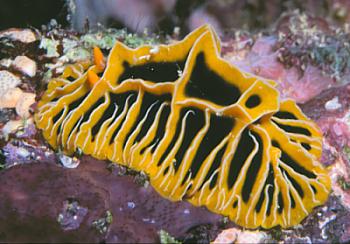Reticulidia halgerda from the Solomon Islands
February 4, 2001
From: Mary Jane Adams

Hi Bill,
I saw this Reticulidia halgerda sitting on the same spot over several days. It was on a point of Karumolun Island, Russell Group, Solomon Islands
Length: 18 mm
Depth: 7 meters
November, 1999
Best regards,
Mary Jane
divepng@yahoo.com
Adams, M.J., 2001 (Feb 4) Reticulidia halgerda from the Solomon Islands. [Message in] Sea Slug Forum. Australian Museum, Sydney. Available from http://www.seaslugforum.net/find/3693Dear Mary Jane,
I wonder if it had found a nice source of food? It might be worth having a look to see if an animal is feeding, or egg laying, or perhaps brooding an egg mass, if you find it in the same spot for a lengthy period of time.
I suspect with phyllidiids, such as Reticulidia you might need to lift them up to see if there is obvious damage to a sponge beneath them. Phyllidiids, have lost their rasping radular teeth so apparently feed by sucking in the sponge tissue after it is reduced to a 'soup' by digestive enzymes 'spat out' through the proboscis. If you lifted one up and it was feeding you would probably find an extended tube-like proboscis. A photo of the sponge it was feeding on, if not a sample of the sponge, would be a valuable bit of information to have about their natural history.
Best wishes,
Bill Rudman.
Related messages
-
Re: Reticulidia halgerda from the Philippines
From: Paul Bourdin, November 18, 2009 -
Reticulidia halgerda from the Philippines
From: Mike Krampf, April 16, 2007 -
Reticulidia halgerda from Fiji
From: Leanne & David Atkinson, May 24, 2006 -
Reticulidia halgerda from Fiji
From: Mary Jane Adams, July 10, 2003 -
Reticulidia halgerda from the Solomons
From: Bruce Potter, September 14, 2001 -
Reticulidia halgerda & R. fungia togetherter
From: Mary Jane Adams, February 4, 2001 -
Reticulidia halgerda & R. fungia
From: Bill Rudman, November 28, 1999 -
Re: Decorated Phyllidia
From: Dr. A.D.Wright, March 25, 1998 -
Re: Decorated Phyllidia
From: Dr. A.D.Wright, March 23, 1998 -
Decorated Phyllidia
From: Dr. A.D.Wright, March 20, 1998
